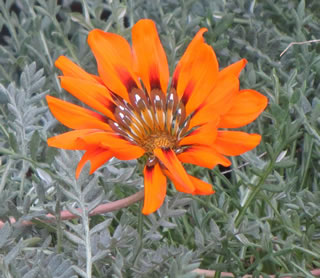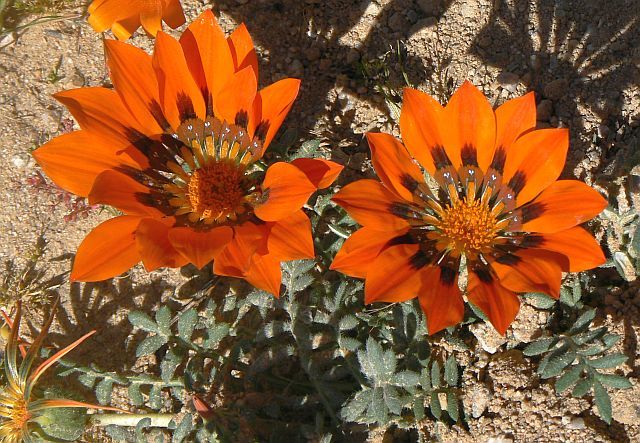
This ground-hugging grassland species is one of the first plants to flower in spring, appearing in profusion as small clumps between low grass tussocks or burnt stubble, or as leafless single flowers seemingly stuck into the soil. Flowering lasts for only a few weeks after the first rains. The buttercup-yellow rays often occur in forms having dark spots at the base.
The showy flowers open only in strong sunlight, closing with fading light and re-opening the following day. This plant is perennial and grows from a woody rootstock. The leaves are tufted and linear in shape, white-felted on the underside, and exuding a milky latex when damaged.

Description
Gazania krebsiana is an extremely showy plant when in flower largely due to its warm and bright flower colour, flower size and its extended flowering period. The plants are semi-decumbent (prostrate to ascending), perennial and herbaceous and reach about 150 mm high. They are therefor aptly referred to as tufted groundcovers and many individuals together may give a rather mat-like appearance, a sight that is all too beautiful when in bloom.
Individually they form rounded tufts on the ground of about 200 mm across with very distinctive foliage. The root system of G. krebsiana is fairly weak and consists of a series of adventitious roots. There is no definite main or taproot meaning the adventitious roots are quite shallow, only about 250 mm deep. This is one of the reasons why these plants react so well to rain and are therefore regarded as excellent pioneer plants.
The leaves may vary in shape especially when young. Mature leaves are usually compound and divided into small, narrow, regular lobes of about 4-6 on each side. They are rough to the touch, dark shiny green on the upper side and woolly white underneath. The main vein is brownish and prominent on the underside. The leaf, including the petiole (leafstalk), can reach a length of 170 mm. Leaves are closely spaced on the short shoots. A distinctive characteristic of Gazania is that the flowering stalks contain a milky sap.
Flowerheads measure 50-60(-90) mm in diameter. The upper side of the ray florets (the florets at the margin of a flowerhead in the Asteraceae) is mainly a magnificent dark red or orange, with dark brown markings on the lower quarter. In some literature the flower colour is referred to as terracotta, hence the common name, terracotta gazania. The dark brown markings may contain black or white spots, adding more eloquence to the flowers. Gazania krebsiana flowers from August till January reaching a peak in October and November.
Status
Due to its adaptability and the abundance of seeds it produces, Gazania krebsiana is well established in all habitats across its distribution range. Seeds are able to travel across large distances and can remain viable for a number of years. The plants are relatively short-lived, up to about three years depending on various conditions. Currently there is no concern of these plants becoming rare or endangered. However, it must be mentioned that many major populations in certain parts of Namaqualand have become heavily reduced, largely due to overgrazing from domestic livestock.
Distribution and Habitat
Gazania krebsiana has a very wide distribution range, mainly within the winter rainfall region of South Africa. It is virtually found in all provinces of South Africa from Namaqualand in the west to the Eastern Cape and KwaZulu-Natal in the east. Northward it extends into the drier interior of the Great Karoo, the Free State and then into some parts of the summer rainfall regions of Gauteng and the Lowveld.
Plants and adaptable and flourish in a host of habitats but are mostly found along roadsides, on flats or lower slopes, exposed hills and rocky outcrops and stony ridges. The latter two habitats are especially ideal in the Namaqualand region of the country. To a lesser extent they may well be found in grassy situations, in montane vegetation and in coastal dune vegetation which is commonly referred to as Strandveld (seaside plants) in the west to south, and thicket in the east. Associated vegetation types include Succulent Karoo, Nama Karoo, Fynbos, Dry Valley Bushveld and Grasslands. Plants seem to tolerate a number of soil types but have a noticeable preference for clay and sandy soil.
Derivation of name and historical aspects
The generic name Gazania, was given in honour of Theodor of Gaza (1398-1478). He was responsible for the translation of the botanical works of Theophrastus from Greek into Latin. Another possibility is that gaza is Greek for riches and could refer to the richness in colour, variety and abundance of the plant. The Afrikaans common name botterblom (butter flower), owes its name to the fact that the ray florets are supposed to taste like butter when chewed. The English common name, terracotta gazania, refers to the terracotta colour of the flowers.

Ecology
Gazani krebsiana is one of those plants that adapt extremely quickly to its environment and therefore is able to survive and multiply easily compared to other plants. In the very dry summer months the plants shrivel and all that is visible is a few very dry, curly leaves. Under these conditions the plants may look dead to the observer, but in fact it is minimising its exposure to the hot sun and saving water loss through its leaves. The woolly underside of the leaves often points upwards and in so doing may help cool the plant down a little. As soon as the rain arrives, plants respond rapidly and the whole plant body swells up and becomes a lush green with leaves erect and the formation of flowerbuds.
Time is crucial for these colourful plants and they have to maximise every opportunity to become as visible as possible so that pollination and the dispersal of seeds can take pace. This is why they are one of the most successful survivors of the Asteraceae. Gazania krebsiana is pollinated by a number of insects: bees, bee flies, beetles, butterflies and ants, have all been seen visiting its bright flowers.
This is another reason why they are able to thrive in most environments, as they do not have any specific pollinators. Monkey beetles are more or less endemic to the winter rainfall region of South Africa. They are essentially pollen feeders, and many species are gregarious, congregating in flowers to feed and mate. The markings at the base of the petals of G. krebsiana, show a striking resemblance to monkey beetles. This appearance of a busy single's bar may well act as an attraction to passing males in search of females.
The brown monkey beetle ( Pachycnema marginella ) often meets and mates on the flowers of G. krebsiana. Each flower head contains about 25 fruits, which are each provided with silky hairs, which facilitate dispersal, by the wind. Ants also play a role in the dispersal of seeds and have been observed carrying seeds underground.
Seeds germinate with ease at the beginning of the rainy season, which commences in April or May. The seedlings grow fast and manage with very little water. They establish their adventitious roots very close to the soil surface to utilize moisture more effectively.
Uses and cultural aspects
They are very good colonizers and are regarded as very good soil stabilizers. Wild and domesticated herbivores are very fond of these plants. Gazania krebsiana and other members of the genus are very valuable for grazing, but are often underestimated. The plants can make a major contribution to the pasture, especially in the dry areas of the winter rainfall region where denuded, trampled patches occur in the veld. Due to unwise subsistence farming in the Namaqualnd region, many Gazania habitats were completely transformed and the plants have become absent from the land.
No comments:
Post a Comment